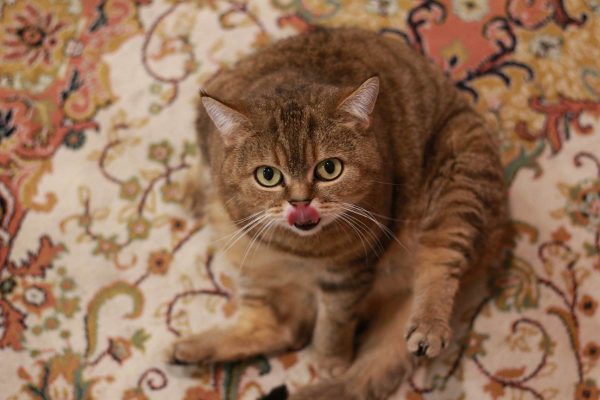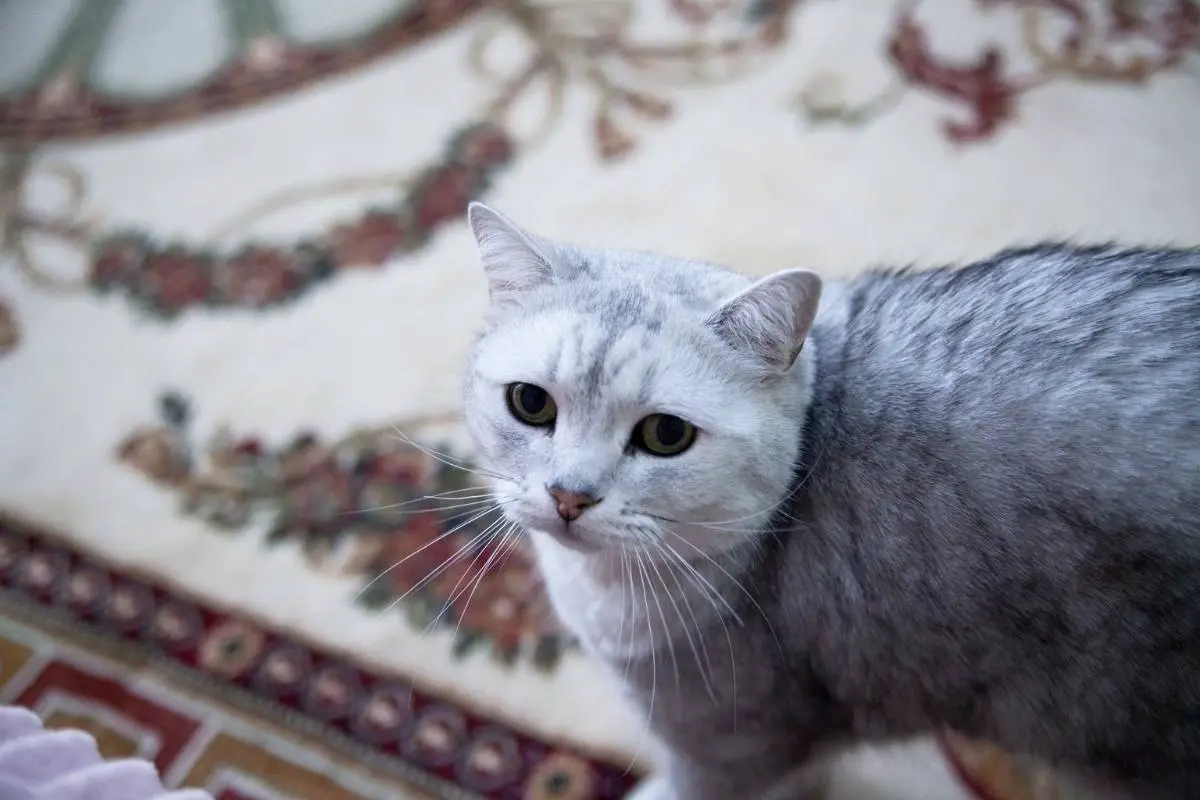Your pet cat loves to explore the parameters of its home, and you might observe your furry friend walking all over the surfaces of your house. However, you might notice your pet avoiding the rugs and carpeted areas in your home. There are a number of factors that could contribute to your feline’s distaste for your rugs and carpet.
Why won’t my cat walk on the carpet? Sharp bits of plastic or other detritus, unpleasant smells, or long nail snags could be deterring your cat from the carpet in your home.
Cats are known for their incredible balance and curiosity, so it’s no surprise to spot them walking along high cabinets or tabletops. However, even with its proclivity for exploration, there may be areas of your house that your cat will avoid. Perhaps you’ve noticed your cat avoiding carpeted flooring, specifically, and there are a handful of methods to determine why. If your cat is avoiding rugs, check your carpet for objects or repulsive scents, or perhaps check their nails or foot pads to ensure nothing is snagging when they try to walk.
Check Your Carpet Fibers

If you want to investigate the cause of your cat’s distaste for carpeted flooring, you might want to start with a quick inspection of the floor itself. Just by running your bare hand over the rug, you might feel small bits of plastic tags, pins, or even gravel that had been trodden in from the outdoors.
Your cat has sensitive feet and a long memory, and one instance of a sharp footstep might be enough to make it avoid carpet long after the incident. Use your fingertips or a coarse brush to comb up any particles lodged in your rug and gently remove them from the fibers. This can help make your carpet more safe for your kitty cat!
If you don’t find any foreign fragments, you might want to turn your attention to the feel of the rug. It’s possible that cleaning substances, room sprays, or other products have saturated your carpet and left behind a grimy residue or unpleasant smell.
Cat’s have a much more sensitive sense of smell, and could be picking up on scents that are imperceptible to the human nose. Stay away from potent or overly chemical cleaning products or air fresheners, and instead opt for natural options that meet the following criteria to clean and refresh your home:
- Baking soda-based
- Vegan-based
- Natural ingredients
- Non-toxic
- No wax-melting pods
- Use plants to purify the air naturally
Searching online or talking to other cat owners could inform you about pet-friendly products to use that won’t leave an unpleasant residue on your rugs.
If you get the sense that it might be time to replace your area rug or carpet, start to look for the warning signs:
– Stains. Even if you’ve treated carpet stains from food or fluids, you could possibly still see the outlines of discoloration. As unsettling as it might be to acknowledge, stains are a visual indicator that there is still residue of the substance in your carpet. This might be bothering your cat’s senses, and could be impossible to fully eradicate.
– Odors. A clean carpet in good condition is odorless, so if you’re smelling staleness or something putrid, it could be time to update your carpet.
– Wear and Tear. Regular use will start to wear on your rugs, and you might begin to see signs that your carpet is getting too old to be sanitary. You’ll notice matting and flatness in high-traffic areas of your carpet, such as hallways or frequently-used rooms.
There might also be fraying or tears around the sealed edges of your carpet. These rips or frayed bits of your carpet could be fixed by a professional or patched.
– Allergy Symptoms. You or your pet could start to experience allergy symptoms such as itching, irritation, or skin rashes. Check your cat for patches of hair loss, itching or biting behaviors, or lethargy as possible indicators of discomfort.
The condition of your carpeted areas can explain why your cat chooses to avoid those paths altogether.
Nails and Scratching
As your cat’s nails get longer, the tiny fibers in a rug or carpeted flooring can catch on their claws and pull or snag. This is, at minimum, uncomfortable for your cat, and even in some cases can be very painful if their nails are continually being tugged.
Housecats can be particular, and will refuse to repeat an action they didn’t like, even preferring to climb way high up or walk the long way around, just to avoid the disagreeable feeling.
To help your cats with this issue, their nails cannot be allowed to grow too long. You can attempt to trim their claws at home with your own nail clippers or small nail scissors. You could also choose to bring your pet into a vet’s office and have a professional clip the nails.
A popular option among pet owners is buying a scratching post or some other scratching accessory so that cat’s file their nails down as they play. According to cat owners, the four most popular cat scratching toys are posts, wave mats, towers, and flexible scratching pads that can be draped over the arm of a couch or across a pad.
Sensitive Paws

Your pet cat has little pads of skin on the bottom of each foot with at least four digital pads for traction and feeling. These little pads react much like human skin, and are intolerant of heat, sharp things, or irritation. It’s possible that your carpet has very coarse or rough fibers that feel too tough against the soft little toe pads on your pet.
Static could be another deterrent for your cat. The friction of the skin-like bottoms of their feet against the nylon, polyester, or wool could create static electricity and agitate your feline, possibly even sparking it.
Static acts as a magnet; once the fibers gain that electric charge, it draws in chemical film, particles, or hair and dander, making even a newly vacuumed carpet feel dirty to the touch. This could also be more of a problem in the dry, winter months.
Cat’s foot paws will get cleaned during one of their routine tongue baths, so you shouldn’t have to wash them often. However, wiping them with a soft cloth can help cleanse them of any grime or dirt.
If their foot pads get too dry, they can peel or crack, certainly making them avoid rough surfaces like carpets. Having a humidifier in the house, or obtaining a topical ointment can help moisturize or heal foot pads in pain. Cats are good at hiding any discomfort, so watch for these symptoms to see if your pet’s feet need some special attention:
- Limping
- Favoring one side over another
- Lethargy
- Staccato, prancing steps
- Reluctance to stand up and walk around unless necessary
- Possible weight loss from refusal to walk to food and water source
Fleas
Carpet is the perfect warm incubator for flea eggs, so once they’ve been brought into your home, they tend to make themselves very comfortable on your soft surfaces. With the size of a flea, it’s almost impossible to spot the little critters with a naked human eye, so you might not even know they’re there until you spot bites or itching.
Your can will likely know about your insect guests before you do. They will feel the little bugs and eggs, and could possibly be avoiding your rugs, blankets, or other soft surfaces.
You can get rid of your fleas by purchasing a simple fogger or flea spray from a store, but if you’re in a pinch and you want to start with a home remedy before buying a product, you can grind baking soda and salt together, sprinkling liberally over your carpets, and letting it sit overnight before vacuuming it up.
Once we know that the environment is clean, let’s focus on making sure our pet is flea-free! If you notice your cat exhibiting excessive itching or biting or patchy hair loss, they might be suffering from little bug bites and irritation.
You can purchase flea and tick shampoos to de-flea your pet at home, or buy flea collars or oil as a preventative measure. Many veterinary offices and pet supply and grooming establishments offer flea treatments for your pet if you don’t want to tackle it on your own.
Conclusion
Your cat is a smart creature, and it remembers discomfort for a long time. It might be avoiding the snagging feeling of carpet in their nails, repelled by strong odors, or simply preferring smoother, cool surfaces to your home’s carpet. Watching your cat’s behaviors, and checking out the environment will give you more information about why your cat is expressing such a preference.

